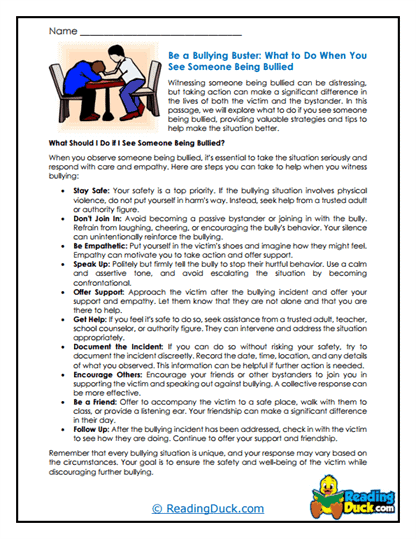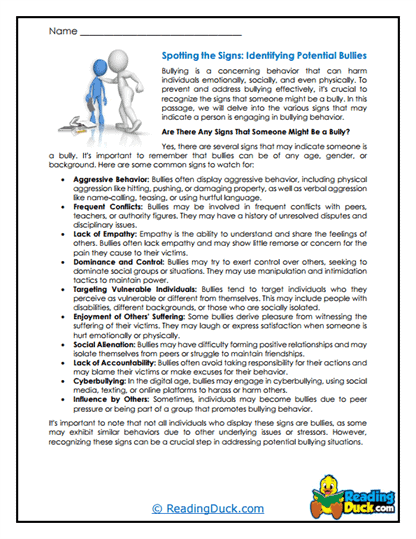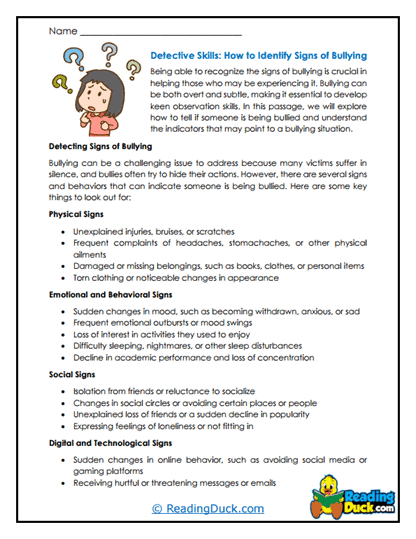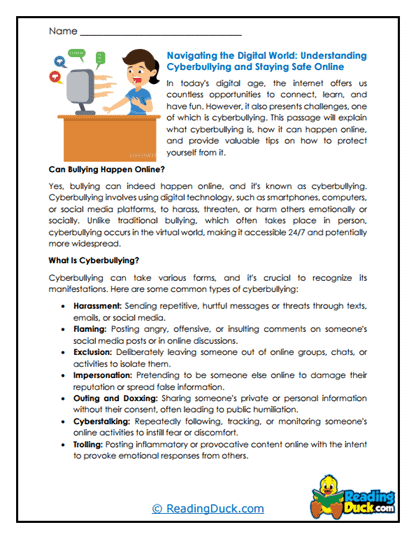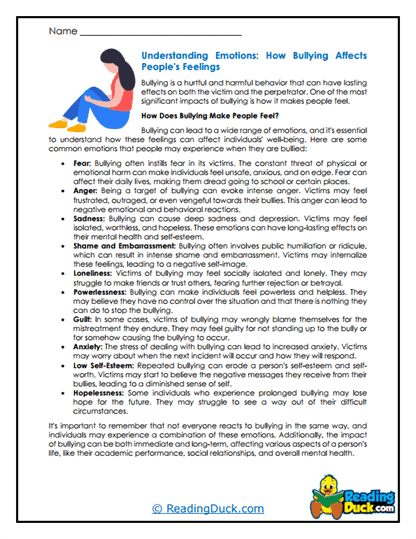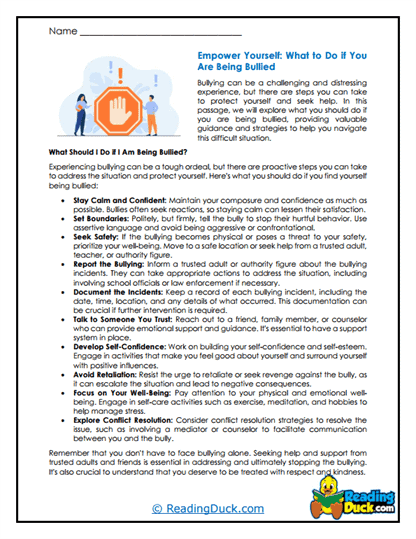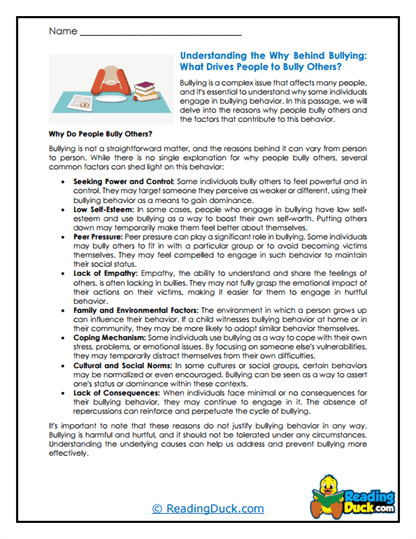Bullying Worksheets
About Our Bullying Worksheets
Our Bullying worksheets are designed to help students understand and address the complex issue of bullying in a way that is engaging, educational, and empowering. These worksheets offer students the opportunity to explore different aspects of bullying, from recognizing the signs to learning how to stand up against it. By providing structured activities and thought-provoking questions, this collection helps students develop empathy, resilience, and strategies for dealing with bullying.
Every topic in this collection contains several worksheet sets, each designed to reinforce students' comprehension and connection to the material through various activities:
- Multiple Choice Questions: These questions assess students' understanding of the reading passages, focusing on key facts and concepts related to the topic. This format helps reinforce students' knowledge and encourages them to engage with the material in a structured manner.
- Short Answer Questions: This format challenges students to reflect on what they’ve learned by writing their responses in their own words. These questions promote deeper thinking and help students articulate their thoughts and insights about bullying.
- Open-Ended Questions: These questions invite students to explore their personal responses to the material, encouraging them to express opinions, preferences, or interpretations related to the topics discussed. This format fosters critical thinking and allows students to connect with the content on a more personal level.
These activities help demonstrate students’ understanding of the material and enhance their connection to the subject matter. Each worksheet set includes an answer key, making it easy for educators to review and evaluate students' progress. All worksheets are available as PDF files, which can be easily viewed electronically, downloaded, and printed.
Understanding Bullying: A Comprehensive Approach to a Complex Issue
Bullying is a pervasive issue that affects students of all ages, impacting their emotional, social, and academic well-being. It’s essential to address bullying from multiple angles, helping students not only recognize when it occurs but also understand the reasons behind it, the different forms it can take, and the steps they can take to prevent or stop it. When presenting this topic to students, it's crucial to emphasize the importance of empathy, respect, and support in creating a safe and inclusive environment.
Key Aspects of Bullying:
- Why People Bully Others: Understanding the motivations behind bullying is key to addressing it effectively. Students will explore the reasons why some people engage in bullying behavior, such as seeking power, dealing with their own insecurities, or mimicking behavior they've seen elsewhere. This insight helps students develop empathy and recognize that bullying often stems from deeper issues.
- Types of Bullying: Bullying can take many forms, including physical, verbal, social, and cyberbullying. Students will learn about each type of bullying, how it manifests, and the impact it has on victims. Recognizing the different types of bullying is crucial for identifying and addressing it in various contexts.
- Teasing vs. Bullying: It's important for students to understand the difference between harmless teasing and harmful bullying. This section helps students distinguish between playful interactions and actions that cross the line into bullying, fostering a clearer understanding of appropriate behavior.
- How to Support a Friend: Being a supportive friend can make a significant difference in the life of someone who is being bullied. Students will learn how to offer support, stand up for friends, and be an ally in preventing bullying. This encourages a culture of solidarity and kindness among peers.
- What to Do When You See Someone Being Bullied: Bystanders play a crucial role in either perpetuating or stopping bullying. This topic teaches students the importance of speaking up, intervening safely, and seeking help when they witness bullying. Empowering bystanders is a key strategy in combating bullying in schools.
- Why Some Kids Don't Tell Adults About Bullying: Many students don't report bullying due to fear, shame, or a belief that nothing will change. This section explores the barriers to reporting bullying and encourages open communication with trusted adults. Understanding these barriers helps educators and parents create a more supportive environment where students feel safe to speak out.
- Identifying Potential Bullies: Recognizing the signs of someone who may be prone to bullying can help in early intervention. Students will learn about the behaviors and attitudes that may indicate a potential bully, allowing them to be more aware and proactive in preventing bullying before it escalates.
- How to Identify Signs of Bullying: Bullying can sometimes be subtle, and the signs are not always obvious. This section helps students and educators identify the physical, emotional, and behavioral signs that someone might be experiencing bullying. Early detection is crucial for providing timely support and intervention.
- What Bullying Is and How to Stop It: A fundamental understanding of bullying and strategies to stop it is essential for all students. This section provides a clear definition of bullying and practical steps for preventing and addressing it. By equipping students with knowledge and tools, we empower them to take action against bullying.
- How Bullying Affects People's Feelings: The emotional impact of bullying can be profound and long-lasting. Students will explore how bullying affects self-esteem, mental health, and overall well-being. Understanding the emotional toll of bullying fosters empathy and encourages students to be more mindful of their actions.
- Understanding Cyberbullying: With the rise of digital communication, cyberbullying has become a significant concern. Students will learn about the unique challenges of cyberbullying, how it differs from traditional bullying, and strategies for dealing with it. This topic is crucial for navigating the complexities of online interactions.
- What to Do If You Are Being Bullied: Empowering students who are experiencing bullying is essential. This section provides practical advice on how to cope with bullying, seek help, and protect oneself. Knowing how to respond to bullying gives students the confidence to take control of the situation and seek support.
These topics provide students with a comprehensive understanding of bullying and its various facets. By exploring these aspects, students can develop the skills and knowledge needed to recognize, prevent, and address bullying in their own lives and within their communities.
Why Students Need to Learn About Bullying
Learning about bullying is crucial for students of all ages because it equips them with the tools to create a safer and more inclusive environment for themselves and others. Understanding the dynamics of bullying helps students recognize when it occurs, understand the impact it has on individuals and communities, and learn effective strategies to address it. By educating students about bullying, we empower them to stand up against harmful behavior, support their peers, and contribute to a culture of kindness and respect.
Moreover, addressing bullying is essential for students' academic and personal development. Bullying can have severe consequences on a student's mental health, self-esteem, and academic performance. By learning how to deal with bullying effectively, students can reduce the negative impact it has on their lives and focus more on their education and personal growth. This knowledge fosters resilience, empathy, and a sense of responsibility, which are valuable skills for their future.
Integrating These Worksheets in a Curriculum
To effectively incorporate our Bullying worksheets into your curriculum, here are some tips for teachers and parents:
- Thematic Lessons: Organize lessons around specific aspects of bullying, such as understanding different types of bullying or exploring the role of bystanders. This approach allows for a focused and in-depth exploration of each topic.
- Role-Playing Activities: Use role-playing exercises to help students practice how to respond to bullying situations. This hands-on approach allows students to apply what they've learned in a controlled, supportive environment.
- Group Discussions: Facilitate group discussions where students can share their thoughts and experiences related to bullying. Encourage open dialogue to help students feel heard and understood, and to foster a sense of community.
- Creative Projects: Encourage students to create posters, videos, or presentations that promote anti-bullying messages. These projects allow students to express their understanding creatively and share their insights with others.
- Peer Mentoring: Implement a peer mentoring program where older students can support younger ones in understanding and dealing with bullying. This fosters a supportive school culture and encourages positive role modeling.
- Use as a Preventive Tool: Incorporate the worksheets as part of a broader prevention strategy, teaching students about empathy, kindness, and respect from an early age. Regular discussions about bullying can help prevent it from occurring in the first place.
- Parental Involvement: Encourage parents to use these worksheets at home to reinforce the lessons learned at school. Parental involvement is crucial in creating a consistent message about the importance of addressing bullying.
- Integrate with Other Social-Emotional Learning (SEL) Topics: Link the bullying worksheets with other SEL topics such as conflict resolution, empathy, and emotional regulation. This integrated approach helps students develop a well-rounded understanding of social interactions.
By integrating these strategies into your curriculum, you can help students develop a deeper understanding of bullying, foster their empathy and resilience, and empower them to take action against harmful behaviors. The Bullying worksheets are a valuable resource that can be used in a variety of educational settings, making the study of this important topic accessible and engaging for all students. Through consistent practice and exploration, students will not only learn about the impact of bullying but also develop the skills needed to create a positive, supportive community.

